If “multifunctional,” “nimble” and “digital” aren’t the first words that come to mind when you think about mattress manufacturing machinery, perhaps it’s time to retool your vocabulary. The way beds are built has changed significantly—thanks, in large part, to advances in machinery.
Research and development departments at equipment companies have been working overtime—not just tweaking their existing models, but creating new high-speed, problem-solving machines that make building today’s more complicated mattresses a cinch. (Well, almost.)
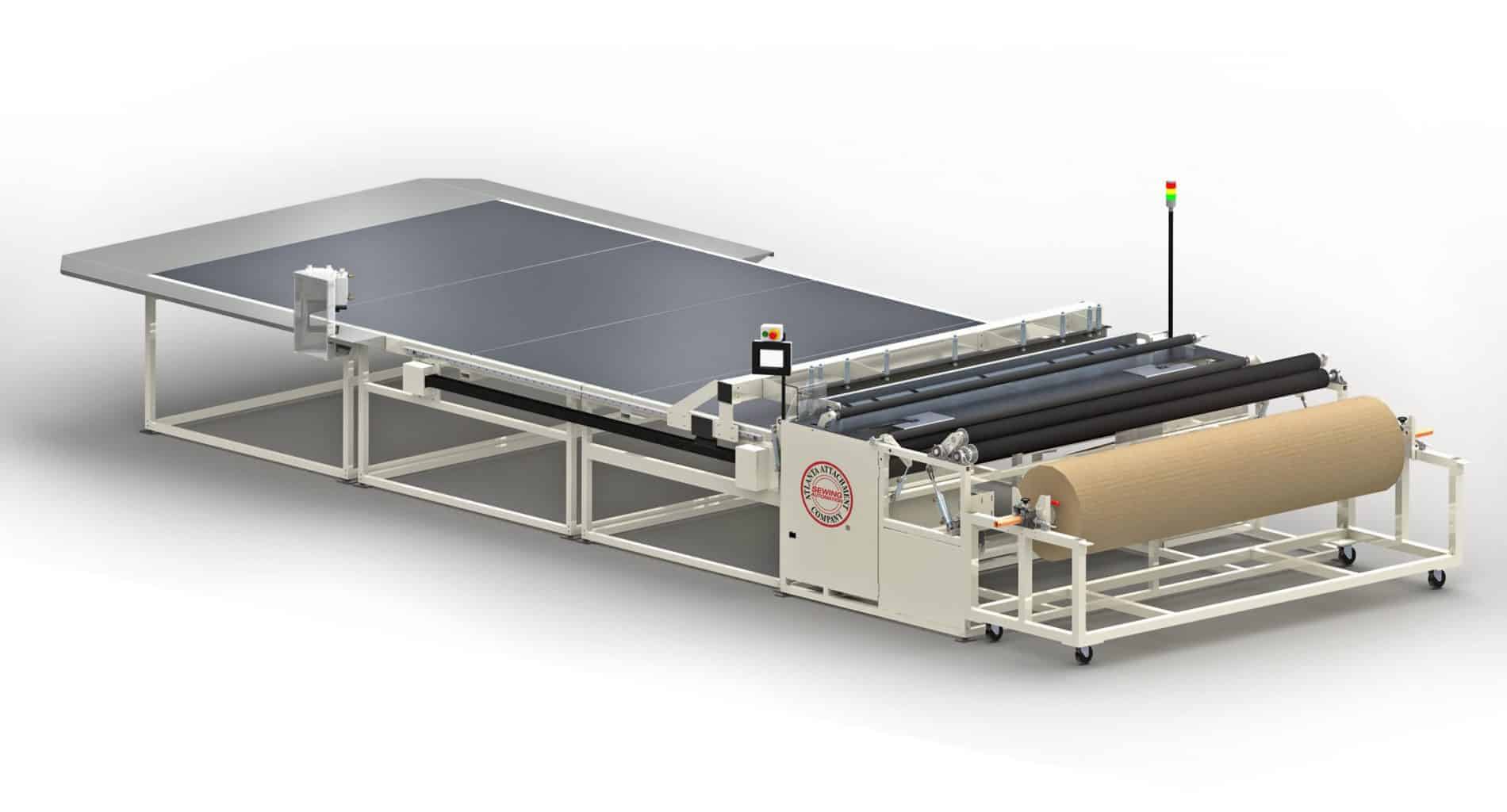
Atlanta Attachment’s 1393KISS Keep It Simple Spreader/Cutter pulls, trims, slits and stacks knit and nonwoven panels.
Consider that mattress design in North America has evolved more in the past decade than it has in the past century. The two-sided innerspring core with a tight-top has all but disappeared. Today’s typical higher-priced hybrid mattress is a one-sided, foam-encased model with pocket springs and layers of memory foam, gel foam or latex covered in a cut-and-sewn zippered cover. Machinery makers have risen to the production challenges that such complex beds create.
BedTimes spoke with a number of machinery suppliers from around the world about trends and innovations in major mattress machinery. Many of the conversations took place on the exhibition floor at ISPA EXPO 2012 in Indianapolis in March.
Machinery is always a focal point of the show and there was much to see, as many suppliers brought out new products and updates designed to help mattress manufacturers keep pace with change.
“For us, the ISPA EXPO is one of the most important shows we participate in. We work diligently to introduce new concepts and designs developed in our research and development center for each show,” says Hank Little, president of Lawrenceville, Ga.-based Atlanta Attachment Co. Inc. (For more images and articles from ISPA EXPO 2012, type “ISPA EXPO” into the search box on this site, or read the March and May digital editions of the magazine.)
Specialty influences
Stretch knits, memory foam and gel foam all are components that got their start in specialty sleep, but now are commonplace in innerspring models, as well. Each poses particular challenges to mattress manufacturers, and machinery companies have worked hard to find solutions.

Masias Maquinaria SA has updated its Direct Feeding System for quilters.
The widespread use of double-knit fabrics has spawned tweaks to existing equipment and a long learning curve in the industry. Helping manufacturers get good finished results with stretchy knits has been a long-term project for machinery suppliers.
One of Atlanta Attachment’s latest additions is the 1393KISS Keep It Simple Spreader/Cutter, a cost-effective solution for pulling, trimming, slitting and stacking knit and nonwoven panels. The machine allows knits to be cut while in a relaxed, slack state. Designed and built in the United States, it has next-generation serial bus controls, as well as safety sensors and switches throughout.
Achieving flat, even seams with a stretchable knit fabric can be difficult. The smallest misstep on a smooth, unquilted mattress cover—especially when joining different colored fabrics together—is almost impossible to disguise.
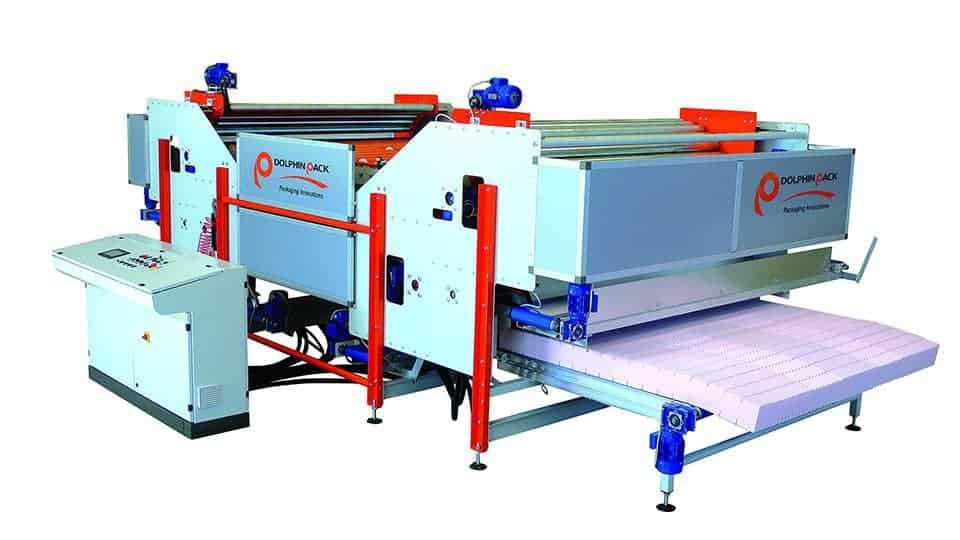
Dolphin Pack has introduced the AliseoDS, a machine that extracts foam cores and brushes away cutting debris from both surfaces.
Gribetz International, part of Carthage, Mo.-based Leggett & Platt’s Global Systems Group, offers a Differentiated-Feed Sewing Machine that allows operators to stitch all types of fabrics together with smooth, perfect seams, regardless of the stretch characteristics or textures of the fabrics being joined.
The specialty sleep category itself continues to grow in importance, leading many manufacturers to invest in foam-cutting equipment.
Albrecht Bäumer GmbH & Co. KG, which specializes in horizontal and vertical CNC (computer numeric control) foam-cutting systems, says it is selling more of those machines than ever to mattress makers.
“In the U.S., our market is changing rapidly. All manufacturers of mattresses are starting to look at buying blocks of foam and cutting it themselves,” says Tanja Blickhäuser, marketing manager for the company, which has worldwide headquarters in Freudenberg, Germany.
Helping manufacturers cut sticky gel foams is one of the latest challenges for manufacturers of foam-cutting machinery. The foams can coat band knives and gum up the inner workings of machines. Bäumer says it has modified components of its foam-cutting machinery so that gel residue is removed from within the machine.

Black Bros. has engineered a new Laser Measuring Device, which attaches to its roll coat machines and gives a thickness reading that is fed to the glue spreader.
Owners of a Bäumer looper can speed up the cutting process with the Accumulator. It’s a new add-on foam storage system that can be installed between the cutting unit and the winding unit on its BSV-E longitudinal cutting machine to hold cut foam. It allows for roller changes on the winding unit without stopping the machine and interrupting the cutting process.
Another Bäumer innovation that increases operational speed is the Unwinding Storage Unit for fiber rolls. It takes the rolls and feeds them automatically into the OFS-VS vertical contour cutting machine.
Bäumer unveiled a machine this year that compresses rolls of cut foam by more than half—depending on the foam density—helping fabricators and mattress manufacturers save on transport and storage costs.
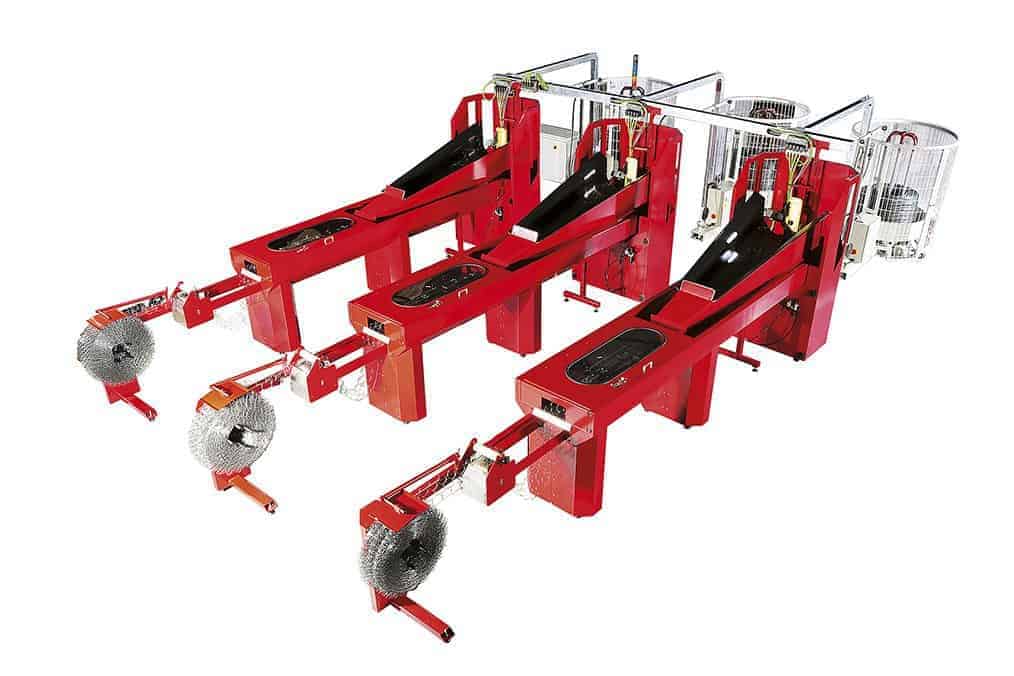
MPT Group Ltd.’s Infinity Sleep Support System is a continuous-wire spring unit fabricator that provides a 45% savings in steel use.
For companies that contour cut their own foam, Dolphin Pack has introduced the Aliseo DS, a machine that extracts the foam core and brushes away cutting debris from both surfaces.
The company designs, builds and fully tests its machinery at its headquarters in Affi, Italy, says Alessia DeTogni, sales and marketing manager. Dolphin Pack specializes in flat-pack machinery such as the new Mistral 3B PRE SV, which uses hydraulics to compress foam blocks or a stack of foam mattresses for transport.
With its 1458 Mattress Stuffer, Atlanta Attachment allows mattress makers to take freshly cut cores and insert them into an FR sock or knit cover with ease. The unit is powered by a belt feed with reverse drive and adjusts vertically and horizontally for multiple sock or knit cover sizes. The company’s 1458200 Sock Closer is a rail seamer that serges and trims excess material using a Pegasus EXT sewing head.
Assembling the interior of multilayer foam and hybrid beds can be as tricky as upholstering their exteriors, which is why Black Bros. Co., with headquarters in Mendota, Ill., has engineered its new Laser Measuring Device, which attaches to its roll-coat machines and gives a thickness reading that is fed to the glue spreader.
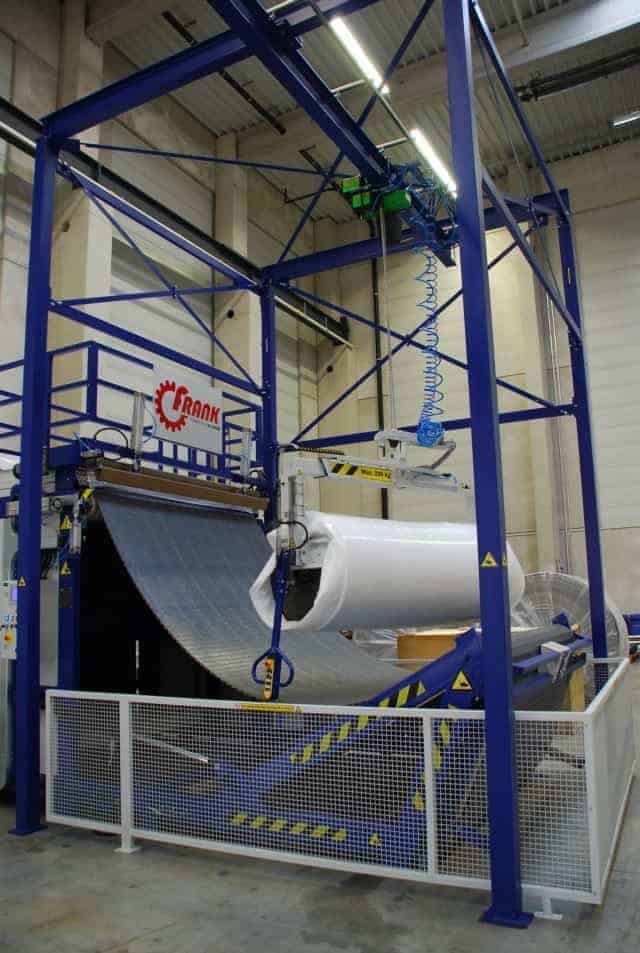
Albrecht Baumer GmbH & Co. KG offers a machine that compresses rolls of cut foam by more than half, helping fabricators and mattress manufacturers save on transport and storage costs.
“Whether foam cuts are 2 inches or 12 inches thick, the operator doesn’t have to hand crank the elevator,” says Todd Phalen, Black Bros. director of North American sales. “As the foam comes toward the glue spreader on a conveyor, its thickness is measured and the drive adjusts the opening on the glue spreader to apply glue in just the right amount. It adjusts automatically if you’re doing all different heights of foam, which is very common today.”
Spring news
In mid-2010, MPT Group Ltd. introduced the patented Infinity Sleep Support System, a continuous–wire spring unit fabricator. The coiler and assembly machine create a spring unit that boasts a 45% savings in steel use—and a smaller carbon footprint, as well as a 150% higher coil count and a 25% taller unit than the typical Bonnell innerspring, according to the company, which has headquarters in Bacup, England.
The Infinity is just one of 30 mattress manufacturing machines available from MPT Group, but is a focal point of the company’s marketing efforts.
The machine’s appeal goes beyond the cost benefit to manufacturers, says Andrew Trickett, MPT Group managing director. “More and more consumers are factoring ‘green’ credentials into their purchase, especially when there is no visible price premium to distract them.”
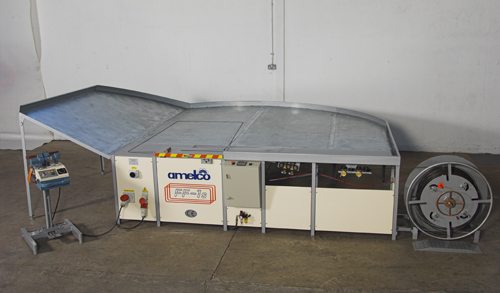
Amelco Border Frame machine now accommodates round-wire forming and bending, in addition to standard steel-strip.
For manufacturers working with traditional innersprings, machinery supplier Amelco Industries Ltd. in Nicosia, Cyprus, has updated its Border Frame Machine in response to requests from U.S. producers. The machine now accommodates round-wire forming and bending, in addition to standard steel-strip.
The fastest quilt
Widespread industry consolidation means that mattress manufacturing operations are larger—and speed and automation are more important than ever to major manufacturers. Digital innovation is automating and speeding up mattress equipment and making plant management more efficient.
When fast quilting is required, GSG says it has just the machine. The company introduced the Gribetz V16 quilter in 2011 and the machine had its North American debut at ISPA EXPO 2012.
The V16 can quilt a panel at a rate of up to 1,600 stitches per minute and is 50% faster than the next quilter in the Gribetz lineup, netting a 20% to 25% greater yield per day, says Russ Bowman, GSG president.
E. Stutznäcker GmbH & Co. KG, with headquarters in Cologne, Germany, makes fast quilters, too. Its innovative top model Mammut VMK Select chain-stitch multineedle quilter has two needle bars and as many as 128 individually programmable sewing positions. Changing needle configurations from one quilt design to another is a simple, programmed step—no operator involvement or other adjustments required. The machine operates at speeds as high as 1,600 rpm.
As with Mammut’s regular-class multineedle quilters, pattern creation software is included as standard equipment on the VMK Select. It offers a broad array of quilt patterns for continuous or tack-and-jump sewing. The VMK also allows for the use of different needles within a quilt pattern, yielding artful single-needle style patterns, the company says. In addition, panel-centered patterns can be cut accurately by employing a panel-marking and detection device, which allows for precise center cutting of quilted panels, regardless of size sequences.
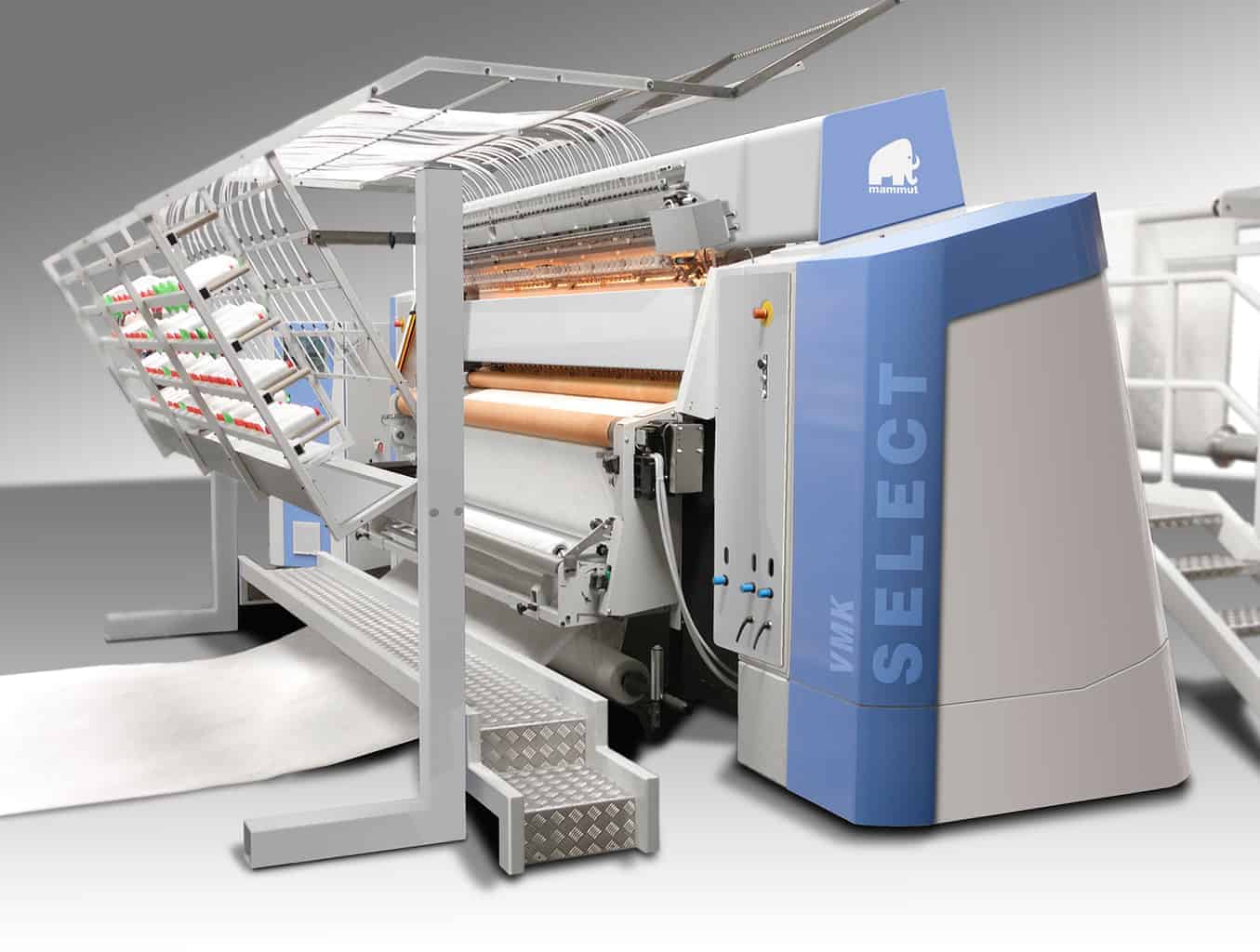
E. Stutznacker GmbH & Co KG’s Mammut VMK Select quilter has two needle bars and as many as 128 individually programmable sewing positions.
Need a high-speed accessory for your high-speed quilter? Masias Maquinaria SA in Girona, Spain, which manufactures fiber processing, filling and quilting machinery, has engineered updates to its Direct Feeding System for quilters. It feeds open polyester fiber into the quilt, eliminating the need for thermo–bonded polyester wadding rolls.
The SAD-30/MF-USW has a small footprint and enables manufacturers to produce fiber panels between two lightweight nonwovens from full bales of polyester at a very high speed, says Sonia Ortiz, Masias area manager.
But all of that super-fast quilting yields a lot of scrap, Ortiz says, and one of her company’s major focuses is equipment that puts post-industrial waste to use.
“More mattress manufacturers are getting interested in efficiently recycling quilt scraps and foam cuts,” she says. “Our machinery can give new value to these recycled fibers or foams, converting them into useful mattress components for quilts, felts or upholstery stuffing. Our automatic blending can blend several components into one finished product with many comfort and cushioning benefits.”
More automation
GSG introduced its EZ Plant system during ISPA EXPO 2012. The production monitoring system allows owners and plant managers to monitor machinery remotely, from anywhere in the world.

James Cash Machine Co. offers the MX-100 The Max tape-edge machine with an adjusting table height.
With the wireless system, mattress makers can connect a node to any number of machines and the software allows them to monitor the machinery’s real-time activity on a computer or mobile phone—anywhere they have online access.
“The system is great for owner-operators who travel frequently or for multinational corporations monitoring multiple plants,” Bowman says. “You can also track trainees to see how they are doing or watch for bottlenecks in the manufacturing system.”
An innovative product from Atlanta Attachment is the new high-tech parts cabinet. The APS1 Automated Parts Management System is a multidrawer unit that dispenses and reorders parts via an embedded computer touchscreen. An array of modular cabinet configurations is available based on a manufacturer’s needs. The cost-saving system is modeled on Atlanta Attachment’s own in-house parts management system and offers a full audit trail and reporting system.
“This system tracks MRO (maintenance, repair and overhaul) parts by both inventory and order entry and supplies the manufacturer information with current data on exactly what their production machinery is costing them in spare parts,” Little says.
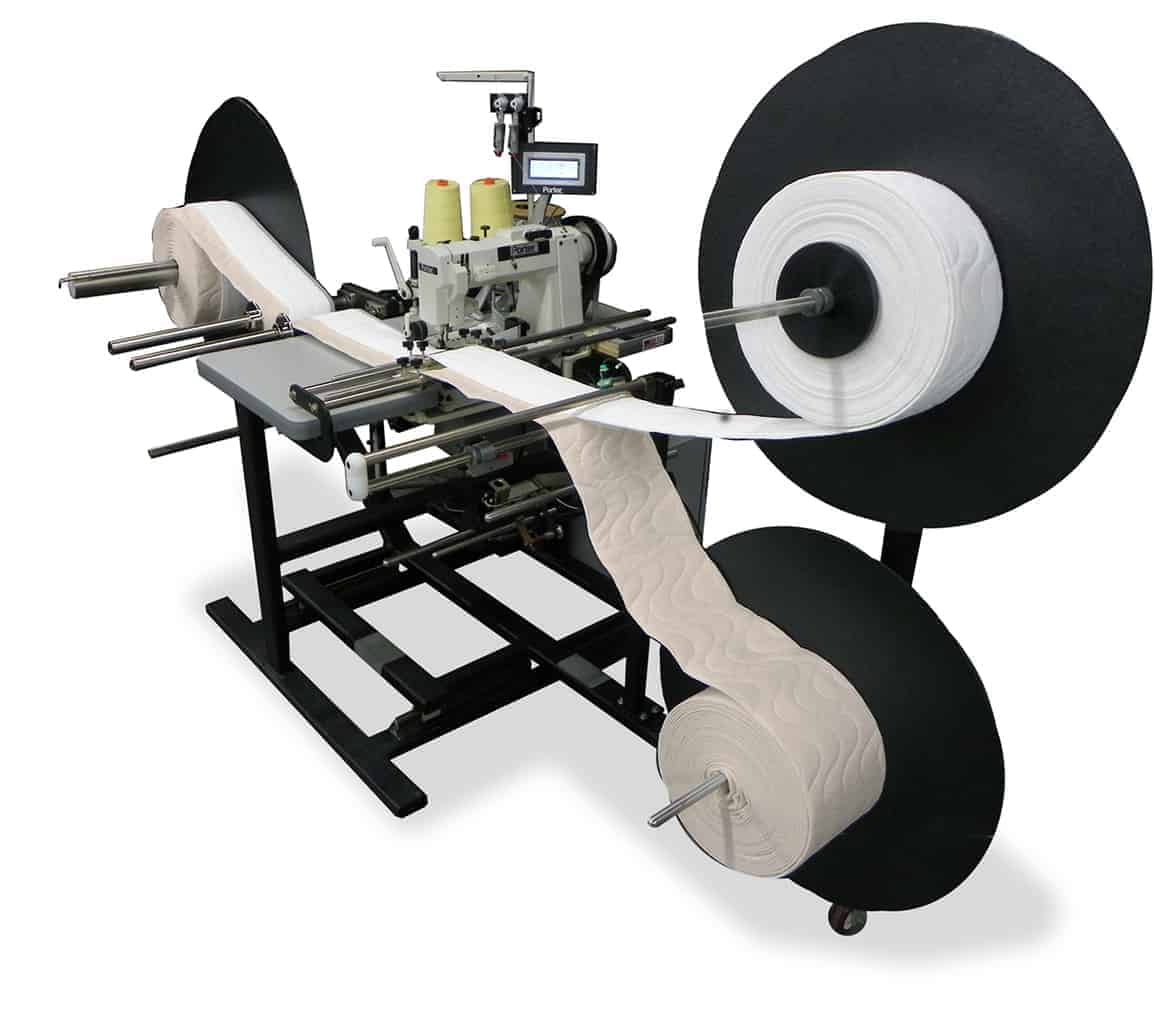
Global Systems Group – Porter BMS-1500 modular border machine
Bäumer offers proprietary software that it says is “totally modular” and can run an entire plant, from point of order to packaging. The software also can operate machinery at night when no one is in the plant, moving and arranging cured foam so it’s ready to be cut in the morning.
“People are looking to reduce the cost of producing mattresses and we specialize in taking the foam and making a mattress with very little human intervention. The more you touch a mattress, the more it costs to produce,” Blickhäuser says.
It’s complicated
Many mattress makers have a love-hate relationship with the souped-up bed borders that help draw consumers’ attention on the retail floor.
As mentioned earlier, one of the biggest new looks on mattresses is the unquilted top panel. It derives from specialty sleep, but has crept onto innerspring beds, too. It’s the blankness of the unquilted top that has given rise to a greater emphasis on high design in mattress borders. With their complexity and sewing techniques, some borders have come to resemble patchwork quilts.
As attractive as they are, all those beribboned, beguiling and be-zippered beds can be a labor-intensive, quality-control nightmare for manufacturers. That’s where some of the latest advancements in border machinery come in.
GSG has harnessed the zipper knowledge of Nähtec to offer a range of zipper machines from both Nähtec and Porter International that allow manufacturers to neatly set zippers in nearly any desired fashion.

Edgewater Machine Co. Inc. engineered the EMCO 9000-3, a three-axis, chain-stitch quilter launched at ISPA EXPO 2012.
“In the last 18 months, decorative borders on foam core and hybrid mattresses have really surged in the marketplace,” Bowman says. “As a result, Porter geared all its new equipment toward unquilted, zipper-cover products.”
Zipper-set machines are becoming as common in North American mattress factories as the ubiquitous tape-edge machine, suppliers say.
Mattress manufacturers are looking to sew their own zippered covers for specialty sleep, as well as perform a host of other border-sewing operations with new multifunctional border machines.
The Porter BMS 1500 offers manufacturers a new modular approach to incorporating zippers and carrying out other border tasks. It adapts to changing mattress styles using interchangeable fixtures that can be purchased as needed. A single machine frame and sewing head can fabricate four different popular mattress border styles: zipper borders, decorative ribbon borders, Cinch-Loc pillow-top gussets or a single border made of varying materials.
“This is a convertible base machine for roll-to-roll border applications,” Bowman says. “With different tooling fixtures, you can perform a range of functions instead of having to buy another $30,000 piece of equipment.”
The Gribetz B45 Border Quilter is fast and has the unique ability to allow operators to sew up as many as four decorative borders at one time. The 45-inch quilting machine can sew ribbons, tapes, continuous handle strips and tack-and-jump, as well as other types of decorative stitching on borders, eliminating the need to do these processes downstream on other machines.
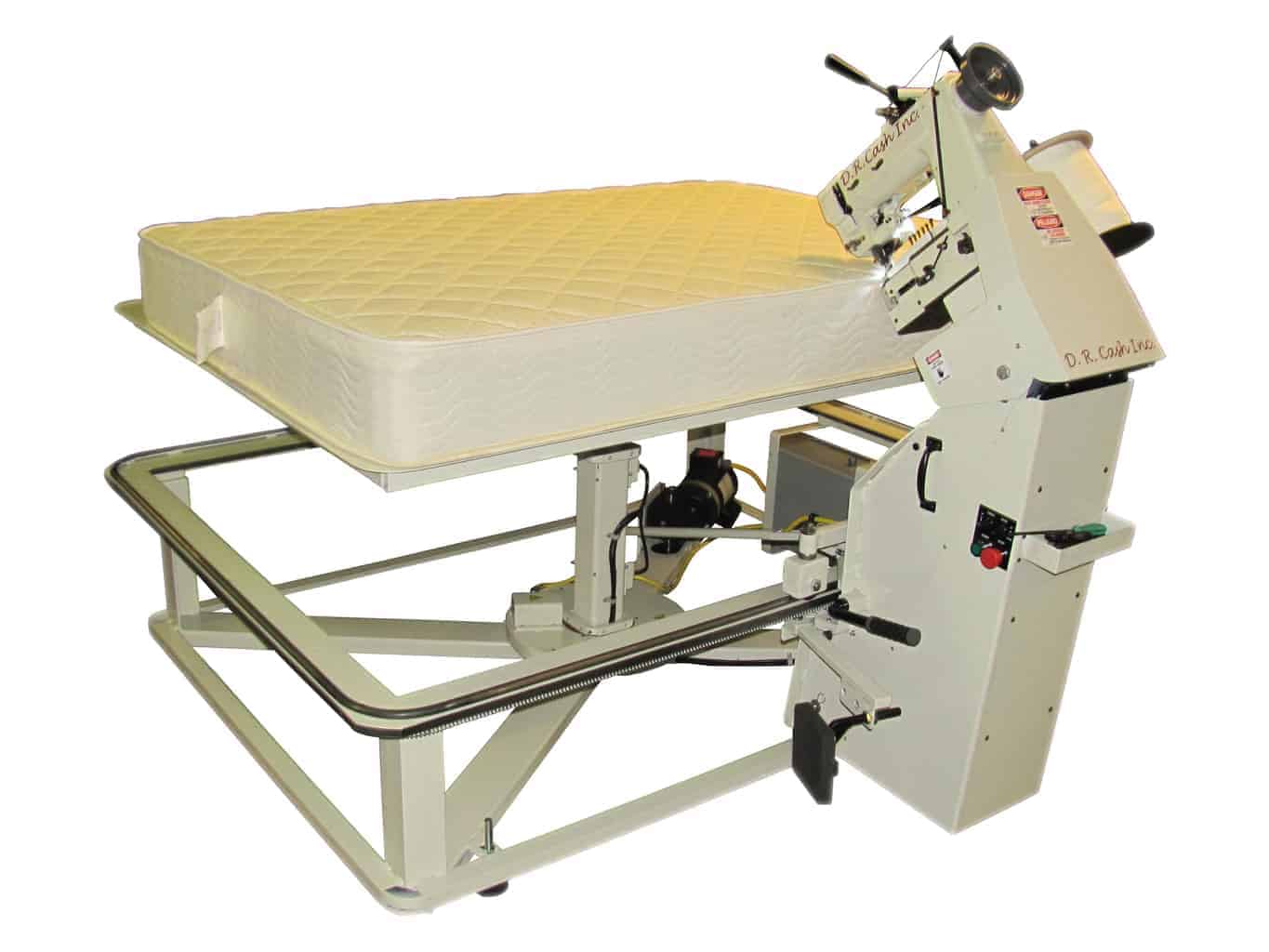
D.R. Cash Inc. DTE11 Electronic Tape-Edge Machine
For tailoring bed borders with fancy seam work, stitching and tapes, Atlanta Attachment offers the 4500 Single Lane Border Quilter and the 4600 Decorative Border Machine. The 4500 is a programmable multineedle sewing system with the capacity to store more than 500 border designs in its memory. It handles borders up to 10 inches wide and has a rewinder for finished borders. The versatile 4600 has an 18-inch wide material capacity and a heavy-duty multineedle sewing head for decorative sewing of both quilted and unquilted borders.
“While the 1330 Auto Border Zipper Workstation is not new, more mattress manufacturers are buying them, bringing zipper-cover construction in-house,” Little adds.
MPT Group recently introduced its Euromax Multifunctional Border Processing System “capable of producing an enormous range of border looks—from inserting spacer fabrics between two independent pieces of border fabric to layering the fabric for a decorative look to inserting accent tapes and other treatments into the bed’s border,” Trickett says. “The system also can sew a euro-top border.”
The importance of quality control
High-end components such as expensive knit panels, gel foam comfort layers and heavy foam cores have made materials handling and quality control a weightier matter for mattress makers than in the past.
To address those issues, both Atlanta Attachment and GSG now offer stainless steel flip tables designed to turn over heavy mattresses without disturbing perfectly aligned seams on unquilted covers.
“With specialty beds, the next operation after adding a sock (with the GBC-1000 ‘sock closer’ and sewing it closed) is to pull a premade zippered cover over the core,” Bowman says. “When you work on the PFT-65 pneumatic flip table, you can turn a heavy mattress over to close the zipper without shifting the seams and corners of the cover. Otherwise, it’s like trying to turn over 160 pounds of Jell-O. It’s both a quality and an ergonomics issue.”
In addition to launching its 1346 Flip Table, Atlanta Attachment now offers the 1470 Material Inspection Station, an electronic inspection machine with multiple light boxes for carefully checking fabric rolls. Smooth, unquilted panel looks mean that even the tiniest textile defect stands out on a bed. The inspection station allows manufacturers to check delivered goods before building beds.
“This is something customers have asked us for for a long time,” Little says. “This allows the end-user of the material to check and inspect raw goods when they are received into inventory. A manufacturer might take every 10th roll and check it on the 1470 to help ensure specifications for his goods are being met.”
Focusing on reliability
D.R. Cash Inc., which is based in Louisville, Ky., specializes in simple, U.S.-made machinery for smaller manufacturers. The company’s focus in recent years has been on re-engineering and fine-tuning its products to be even more cost-effective to operate and maintain, says Tommy Johnson, D.R. Cash chief engineer. “These machines are workhorses. They don’t cost too much upfront and don’t cost too much down the line in parts and maintenance. They do the job and do it well.”
Johnson is talking about equipment such as the THS12 Mattress Bag Heat Sealer and the fully electronic, yet cost-effective DTE11 Electronic Tape-Edge Machine.
“Our business is strong right now,” he says. “Our goal was to make it easy for the mechanics. We minimize moving parts and they can buy replacement parts from us or get their parts at (equipment and parts supplier) W.W. Grainger Inc. Our machine is computerized, but it’s simple. We install the computer in the back and basically you should never have to touch it or reprogram it again.”
Edgewater Machine Co. Inc., a quilting machinery supplier in College Point, N.Y., launched the EMCO 9000-3, a three-axis, chain-stitch quilter engineered for operator convenience at ISPA EXPO 2012.
“We do the opposite of what many competitors do. We’re not trying to save costs by sourcing in China or lightening the machines,” says Roy Schlegel, EMCO company principal. “We decided to build heavier, stronger machines. We want customers to know that ‘Made in America’ is important to us. People see the quality and they love it.”
The 9000-3 has an electronic light curtain that allows quick, easy access to machine components when the machine is turned off. There are no Plexiglas guards and doors to open. The machine is touted as 95% maintenance-free, with no oiling points. All moving parts are sealed ball bearings. One hundred patterns are included in the software package and there is memory storage for thousands of designs.
Sourcing quality parts is a top priority at James Cash Machine Co. in Louisville, Ky., says President Linda Ferry.
“We make sure we keep our quality up,” she says. “We’ve been unable to find a high-quality vendor in China. We research countless hours to make sure we use quality parts. Some are from Japan; some from Taiwan. We source from U.S. distributors and we make some parts in-house or we source them locally. For instance, our tape-edge machine has a very good clutch that is sourced locally.”
Ease of operation also is a priority and inspired the company to design MX-100 The Max tape-edge machine with a table height that adjusts from 28 inches to 43.5 inches.
“Once it was the guy with the longest arms and legs who operated the tape-edge machine,” Ferry says. “Today, people of all shapes and sizes are building beds.”
The company also prides itself on trouble-shooting for customers.
“We’re here to help,” Ferry says. “We enjoy answering the phone and if we can’t help them, we have our electrician or another specialist help them.”
Deciding to buy
Seven questions to ask when considering a machinery purchase:
1) Can you afford to invest in new equipment? What are your financing options?
2) Have quality control and overall product quality become an issue in your factory?
3) Are you meeting your customers’ just-in-time delivery needs? Is your plant’s productivity keeping pace with your competition?
4) Has excessive downtime due to short process interruptions—or outright equipment failure—become a problem?
5) Are you keeping pace with new sewing and construction techniques for mattresses? Will an investment in new machinery assist you in your new product development strategy?
6) Does your workforce engage in labor-intensive workarounds to get older equipment to produce desired results?
7) What will be the payback on your investment, both short-term and long-term?
MACHINERY MAKERS
To find suppliers of mattress machinery, check the BedTimes Supplies Guide.




